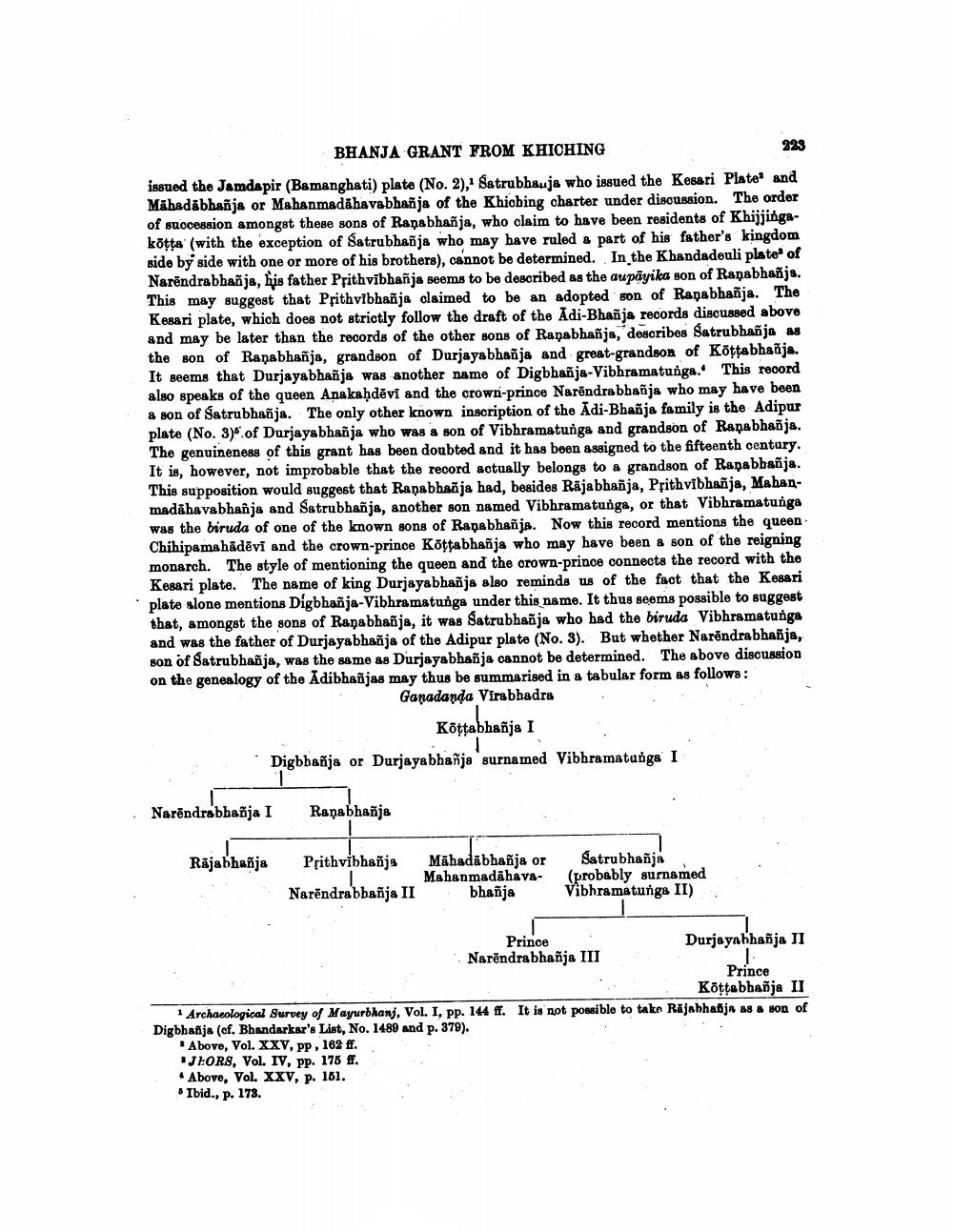________________
323
BHANJA GRANT FROM KHICHING issued the Jamdapir (Bamanghati) plate (No. 2), Satrubhauja who issued the Kesari Plates and Mabadabbañja or Mahanmadahavabhañja of the Khiching charter under disoussion. The order of succession amongst these sons of Ranabhañja, who claim to have been residents of Khijjingakõtta (with the exception of Satrubhañja who may have ruled a part of his father's kingdom side by side with one or more of his brothers), cannot be determined. In the Khandadeuli plate of Narēndrabhañja, his father Prithvibhañja seems to be described as the aupāyika son of Ranabhañjs. This may suggest that Přithvibhañja claimed to be an adopted son of Ranabhañja. The Kesari plate, which does not strictly follow the draft of the Adi-Bhañja records discussed above and may be later than the records of the other sons of Ranabhañja, describes Satrubhañja as the son of Ranabhañjs, grandson of Durjayabhañja and great-grandson of Kottabhažja. It seems that Durjayabhañja was another name of Digbhañja-Vibhramatunga. This record also speaks of the queen Anakaḥdēvi and the crown-prince Narēndrabbaõja who may have been & son of Satrubhañja. The only other known inscription of the Adi-Bhañja family is the Adipur plate (No. 3) of Durjayabhanja who was a son of Vibhramatunga and grandson of Ranabhaõja. The genuineness of this grant has been doubted and it has been assigned to the fifteenth century. It is, however, not improbable that the record actually belongs to a grandson of Ranabbañja. This supposition would suggest that Ranabhañja had, besides Rajabhañja, Prithvibhañja, Mahanmadahavabhanja and Satrubhañja, another son named Vibhramatunga, or that Vibhramatunga was the biruda of one of the known sons of Ranabhañja. Now this record mentions the queen Chihipamahädēvi and the crown-prince Köttabhañja who may have been & son of the reigning monarch. The style of mentioning the queen and the crown-prince connects the record with the Kesari plate. The name of king Durjayabhañja also reminds us of the fact that the Kesari plate alone mentions Digbhañja-Vibhramatunga under this name. It thus seems possible to suggest that, amongst the sons of Ranabhañja, it was Satrubhañja who had the biruda Vibhramatunga and was the father of Durjayabhañja of the Adipur plate (No. 3). But whether Narēndrabbañja, son of Satrubhañja, was the same as Durjayabhañja cannot be determined. The above discussion on the genealogy of the Adibhañjas may thus be summarised in a tabular form as follows:
Ganadanda Virabhadra
Kottabhañja I Digbbañja or Durjayabhañja surnamed Vibhramaturga I
Narēndrabbañja I
Ranabhanja
Rajabhañja
Prithvibhañja Mähadābhañja or
Mahanmadāhava- Narēndrabbañja II bhañja
Satrubhanja (probably gurnamed Vibhramatunga II)
"
Prince
Durjayabhañja II Narēndrabhañja III
Prince
Kõţtabhañja II 1 Archaeological Survey of Mayurbhanj, Vol. I, pp. 144 ff. It is not possible to take Rajabhapja as a son of Digbhafija (cf. Bhandarkar's List, No. 1489 and p. 379).
*Abovo, Vol. XXV, PP , 162 ff.
JHORS, Vol. IV, pp. 176 ff., * Above, Vol. XXV, p. 161. • Ibid., p. 178.




